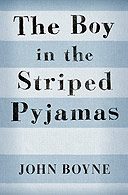Educating
Bruno
The slow revelation of detail in David Fickling's Holocaust story for children, The Boy in the Striped Pyjamas, impresses Kathryn Hughes
The Boy in the Striped Pyjamas
by John Boyne
Bruno is a nine-year-old from Berlin who has three best Friends For Life, an elder sister who is a Hopeless Case, and an ambition to be an Explorer. One day in 1943 someone called The Fury decides that Bruno's soldier father is to be posted, together with the whole family, to somewhere called Out-With, which is far away from Berlin, and quite possibly not in Germany at all. The new house is bleak and shabby, and from one side of it you can see a high-wired compound inhabited by sad-looking people in striped pyjamas.
The great strength of Bruno's narrative is the way it is mired in the parochial preoccupations of a nine-year-old. While he is vaguely interested in what the striped-pyjama people do all day, his really righteous anger is reserved for Lieutenant Kotler, a supercilious 19-year-old on his father's staff, who insists on ruffling his hair and calling him "little man". Likewise, it is not until he needs an ally in his campaign to get the household shifted back to Berlin that Bruno bothers to wonder about Maria, the invisible maid who has been folding his clothes and running his baths for as long as he can remember.
For the older reader, of course, Bruno's innocence comes to stand for the wilful refusal of all adult Germans to see what was going on under their noses in the first half of the 1940s. For the younger reader, perhaps even as young as Bruno himself, the slow revelation of detail - the striped-pyjama people are very thin, they aren't allowed to leave the compound, they used to live somewhere else entirely - becomes an education in real time of the horrors of "Out-With", known to the grown-ups as Auschwitz.
Given that he lives in a house of partial views and suppressed conversations, the agent of Bruno's enlightenment comes, naturally enough, from beyond its four walls. Exploring the perimeter of the camp he encounters a boy from the striped-pyjama side called Schmuel. Over the next few months the two children swap life stories through the mesh fence. Schmuel explains how he and his family have been transported here from a ghetto in Poland. Bruno counters with stories of the niceness of his life in Berlin and the stray, worried thought that next time he should probably bring his new friend some food. (He tries, but since being an Explorer is such hungry work, he has the unfortunate habit of polishing off the bread and chocolate before arriving at their rendezvous.)
One of the great triumphs of this book is the way that John Boyne manages the shift in register from the intensely concrete inner world of his child narrator - a place where an elder sister's pigtails or the corner of a bedroom window are branded on your inner eye - to something that borders on fable. It turns out, for instance, that both Bruno and Schmuel were born on the same day, at a stroke turning them into narrative doubles and psychic twins. And then there is the oddness of Auschwitz security being so lax that a child prisoner could make a weekly date with the commandant's son without anyone noticing.
Any slight bumps in tone are smoothed away as the narrative definitively slips anchor and moves into its final urgent stages. Schmuel's father goes missing inside the camp, and Bruno, with his Explorer credentials, insists on helping to find him. Putting on a spare pair of striped pyjamas and scrambling under a loose piece of netting, Bruno is finally able to join Shmuel on the other side of the fence and becomes lost for ever.
The Boy in the Striped Pyjamas is a small wonder of a book. Bruno's education is conducted slowly, through a series of fleeting social encounters rather than by plunging him into a nightmare landscape. A scraped knee, an attack of nits, a slammed door - these are the moments through which he is led to a deeper knowledge of the world beyond the wire fence. And yet there is nothing muffled or held back about Bruno's fate. When, in the book's final scene, the two small boys walk hand in hand into the gas chamber, they do so not as narrative symbols but as two flesh-and-blood children caught up in a particular historical moment, one that cannot be told too often or too young.


No comments:
Post a Comment
To register for this chapter write your name below: